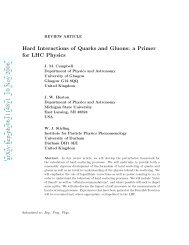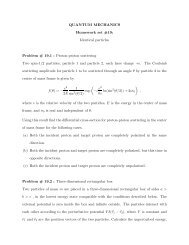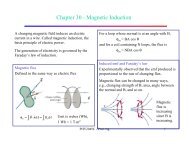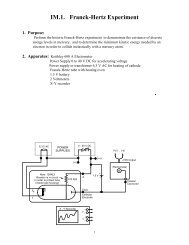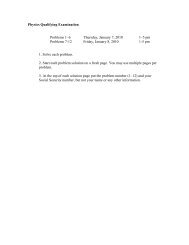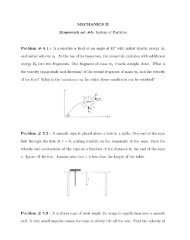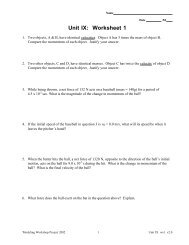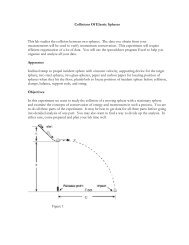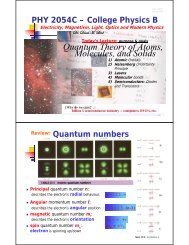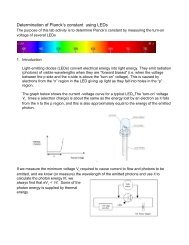You also want an ePaper? Increase the reach of your titles
YUMPU automatically turns print PDFs into web optimized ePapers that Google loves.
thus p (in MeV/c) = 2.998•10 8 R B •10 -6 = 300 R (in m) B (in T)Measurement <strong>of</strong> anglesDraw straight lines from the point <strong>of</strong> primary interaction to the points where the Λ 0 and the K 0decay. Extend the lines beyond the decay vertices. Draw tangents to the four decay product tracks atthe two vertices. (Take care drawing these tangents, as doing it carelessly is a source <strong>of</strong> largeerrors.) Use a protractor to measure the angles <strong>of</strong> the decay product tracks relative to the parentdirections (use Fig. 3 or 4 for measurements and Fig. 2 for definitions).Note: You can achieve much better precision if you use graphics s<strong>of</strong>tware to make themeasurements, rather than ruler and protractor on paper. Examples <strong>of</strong> suitable programs areGIMP or GoogleSketchUp, both <strong>of</strong> which can be obtained for free.<strong>Analysis</strong>The laws <strong>of</strong> relativistic kinematics relevant to this calculation are written below. We use thesubscripts zero, plus, and minus to refer to the charges <strong>of</strong> the decaying particles and the decayproducts.p + sinθ + = p - sinθ - (2)p 0 = p + cosθ + + p - cosθ - (3)E 0 = E + + E - ,where E + = √(p + 2 c 2 + m + 2 c 4 ) , and E - = √(p - 2 c 2 + m - 2 c 4 )m 0 c 2 = √(E 0 2 - p 0 2 c 2 )Note that there is a redundancy here. That is, if p + , p - , θ + , and θ - are all known, equation (2) is notneeded to find m 0 . In our two-dimensional case we have two equations (2 and 3), and only oneunknown quantity m 0 , and the system is over-determined. This is fortunate, because sometimes (ashere) one <strong>of</strong> the four measured quantities will have a large experimental error. When this is the case,it is usually advantageous to use only three <strong>of</strong> the variables and to use equation (2) to calculate thefourth. Alternatively, one may use the over-determination to "fit'' m 0 , which allows to determine itmore precisely.A. K 0 decay1. Measure three <strong>of</strong> the quantities r + , r - , θ + , and θ - . Omit the one which you believe wouldintroduce the largest experimental error if used to determine m K . Estimate the uncertainty <strong>of</strong>your measurements.2. Use the magnification factor g to calculate the actual radii R and equation (1) to calculate themomenta (in MeV/c) <strong>of</strong> one or both pions.3. Use the equations above to determine the rest mass (in MeV/c 2 ) <strong>of</strong> the K o .4. Estimate the error in your result from the errors in the measured quantities.5.4




